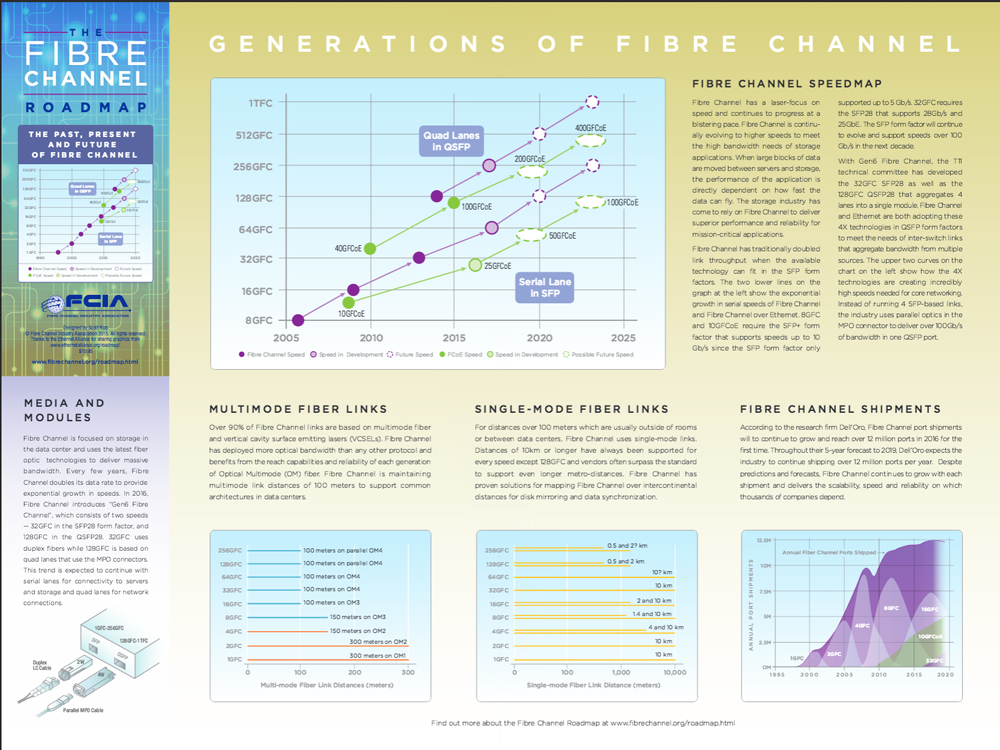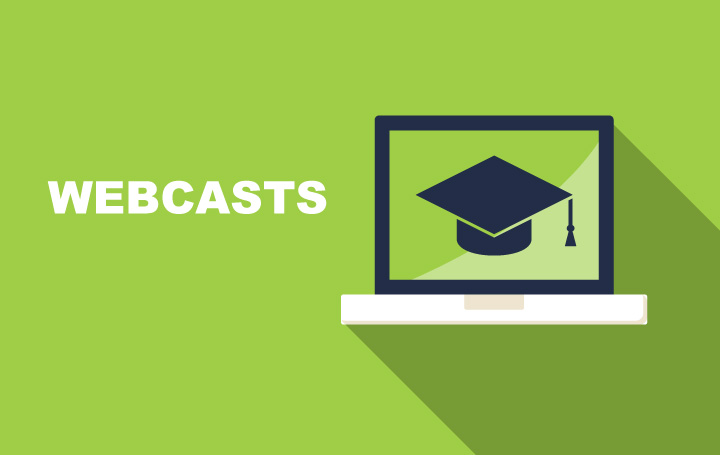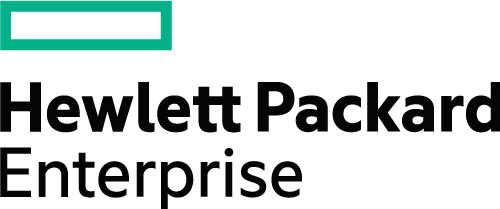Roadmap Illustration
Featured Video
Webcasts
Presenters:
- Andy Adams, Adtran
- Gene Cannella, Adtran
- Moderator: David Rodgers, EXFO
Watch on FCIA Youtube Channel
Watch on-Demand on BrightTalk
Click here to view the presentation slides.
Organizations often operate data centers in multiple locations and are often geographically distributed to provide scale and disaster recovery capabilities. As with any fabric topology, scalability, data integrity and security are key requirements. This webinar will discuss how Fibre Channel can be effectively deployed in these applications using optical transport technology. Topics to be covered:
- Optical Transport 101: A brief survey of optical networking (DWDM) technology
- Fibre Channel transport via OTN
- Robustness: Optical transport protection options: Resiliency against fiber outages
- Security: Optical transport OTN encryption: No-overhead layer 1 encryption that can be combined with IPSec or other higher-layer security protocols
Presenters:
- Kamal Bakshi, Cisco
- Mark Jones, Broadcom
- Nishant Lodha, Marvell
- David Rodgers, EXFO
Watch on FCIA Youtube Channel
Watch on-demand on BrightTalk
Click here to view the presentation slides.
The majority of today’s SAN infrastructure leverage the traditional SCSI/FCP protocol. The relatively new NVMe/FC protocol has become ubiquitous in enterprise storage offerings, delivering multiple advantages including high performance, low tail latency, and precision error recovery that can run on the same FC SAN infrastructure. In this talk we will discuss:
- The architecture of NVMe/FC at protocol level
- Building blocks of NVMe like NVMe subsystem
- NVMe controllers, Namespaces etc.
- Overview of FC-NVMe T11 standards
- Key advantages of NVMe/FC, including application use cases
Presenters:
- Mark Jones, Broadcom
- Kiran Ranabhor, Cisco
- Dean Wallace, Marvell
Click here to watch on-demand
Click here to watch on the FCIA Youtube channel.
Click here to view the presentation deck.
In this webcast we will discuss 128GFC, the new Fibre Channel speed recently ratified by the T11 Fibre Channel standards committee. This new speed takes Fibre Channel further into the future. The latest generation of Fibre Channel (128GFC) has a rate of 112.2Gbps (PAM4) for a single lane variant. This speed is 5.6% faster than 100Gb Ethernet single lane variants. Fibre Channel was able to increase the speed and still maintain two generations of backward compatibility which is key to Fibre Channel success. Previous generation SFP optical modules (32GFC and 64GFC) will be able to plug into the latest generation of Fibre Channel 128GFC products and 128GFC products will be able to seamlessly interoperate with previous generations of Fibre Channel products.
128GFC products will support existing infrastructure of fiber cables for multi-mode variants and single mode variants. 128GFC is also able to support the previous reach of 100 meters of OM4 without sacrificing performance in link quality or increasing errors (BER).
The Fibre Channel committee also streamlined the process for link speed negotiation and training which are key to multiple generations of backward compatibility. In the webcast we will discuss this significant Fibre Channel advancement.
Presenters:
- Nishant Lodha, Marvell
- Ramya Krishnamurthy, HPE
- Rupin Mohan, HPE
- Ajay Kumar , HPE
- Ashish Neekhra, HPE
Click here to watch on FCIA’s Youtube Channel
Click here to watch on BrightTalk
Click here to view the presentation slides.
Machine learning (ML) is the study and development of algorithms that improves with use of data. As it deals with the training data, the machine algorithm changes and grows. Most ML models begin with “training data” which the machine processes and begins to “understand” statistically.
Machine learning models are resource intensive. To anticipate, validate, and recalibrate millions of times, they demand a significant amount of processing power. Training an ML model might slow down your machine and hog local resources.
The proposed solution is to containerize ML with NVMe over Fibre Channel (FC-NVMe) by putting your ML models in a container. In this webcast, we will highlight the benefits of containerizing ML models with FC-NVMe, discussing:
- Containers are lightweight software packages that run-in isolation on the host computing environment. Containers are predictable, repetitive, and immutable. This ensures that no unexpected issues occur while moving them to a new system or between environments. A cluster of containers can be created with a configuration suited for machine learning requirements. Containers are also easy to coordinate (or “orchestrate”).
- Artificial Intelligence (AI) at scale sets the standard for storage infrastructure in terms of capacity and performance, making it one of the most crucial factors for containers.
- FC-NVMe is an extension of the NVMe network protocol to Fibre Channel delivering faster and more efficient connectivity between storage and servers and providing the highest throughput and fastest response times.
- The combination of FC-NVMe with an NVMe SSD solution with containerized ML allows orchestration to scale data-intensive workloads and increase data mining speed.

Fibre Channel Solutions Guide
Happy Anniversary to the Fibre Channel Industry Association (FCIA) – 30 years and still going strong! For three decades…
In-memory databases have been around for a long time. They operate by managing data in random access memory (RAM) instead of the non-volatile storage that traditional relational database management system (RDBMS) databases rely on. An in-memory database runs…
I cannot wait for self-driving cars! I want to be able to hop in my car, say, “go to work,” and have it get me there safe and sound – under any circumstances. Yet, with all of the advancements…
As data demands continue to grow exponentially, the need for robust and reliable high-speed data transport solutions is paramount. 64G Fibre Channel (64GFC) technology is becoming a critical tool in the arsenal of modern data centers…
Data breaches are becoming more frequent and more expensive. In industries categorized as critical infrastructure – health care, financial services, pharmaceutical, energy, transportation, and industrial – the losses are significantly higher than in other sectors…
The technology landscape is continuously evolving with ever-growing demands for faster data access, storage, and transmission. One of the latest advancements in this domain is the introduction of the 128GFC (128 Gigabit Fibre Channel), often called Gen 8. Fibre Channel has long been the go-to protocol for mission critical, high-performance storage networks, primarily in data centers. This new iteration promises to significantly boost data throughput, reduce latency, and provide greater scalability….















